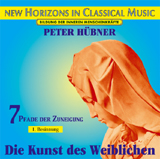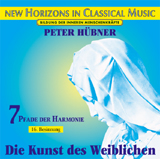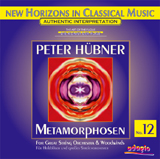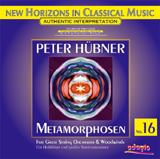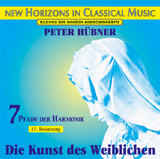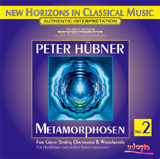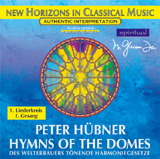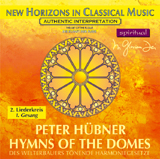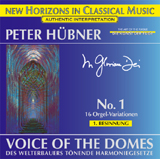“The soul
of man is not an organ but animates and exercises all the organs; it is not
a function like the power of memory, of calculation, of comparison, but uses
these as hands and feet; it is not a faculty, but a light; is not the intellect
or the will; is the vast background of our being in which they lie –
an immensity that is not possessed and cannot be possessed.”
Ralph Waldo Emerson
Philosopher
______________
“I consider this the best definition of this power ever given the world.
St. Paul gave a similar, more concise description of it in Acts 17:28, ‘For
in Him we live and move and have our being.’
It is the same power on which Bach, Mozart and Beethoven drew and on which
all composers are dependent if they wish to create anything worth while.
He who consciously
appropriates this inner force is inspired but technically he must be adequately
equipped to present the inspired ideas on paper convincingly.”
Max Bruch

„It is through
the Temple
of Music
we approach
Divinity.
It is here
we Experience
our true
Resurrection.“
Goethe
„Anyone
who seriously
researches Nature
must have experienced
a sense of
religious Consciousness.“
Albert Einstein
|
|
THE COMPOSER ON
THE ART
OF THE FEMININE |
|
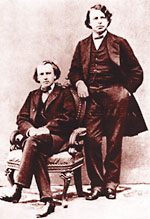 Johannes Brahms (sitting)
Johannes Brahms (sitting)
and Joseph Joachim
Johannes Brahms
in discussion with the famous violinist
and friend
Joseph Joachim
“All this is most fascinating, Johannes, and I understand now why you have always
been so aloof in this respect, even with me. We are now treading on holy
ground. But if you feel that Bach, Mozart and Beethoven were more inspired
than you were, what do you think of me?
As a young man, I, too, composed, but since associating with you so intimately,
I have long since given it up; your inspirations were of a so much higher
order than mine, your workmanship also, that further effort on my part seemed
futile.
My compositions, even my Hungarian Concerto, are being more and more neglected
and will soon be forgotten, while yours are gaining in recognition from
year to year.”
“That is true, Joseph, but it will be another half century before I shall find
my true place in the musical scheme. It is difficult, if not impossible,
to explain why one composer is more inspired than another, but I can put
my finger on one weak spot in your past, Joseph – too many official
positions and posts of honour. You are the director of the Berlin Royal
High School, you are in great demand as a violin soloist and as a quartet
player, you devote a great deal of your time to teaching; the many conferences
connected with your posts of honour encroach upon your time; you are flooded
with manuscripts of composers for violin who seek your advice – to mention only a few of the troublesome and annoying inconveniences which
have come within the scope of my own observations. All these things interfer
with composing.
A composer who wishes to write worth-while music must devote his whole time
and energy to that one occupation. If I had had as many calls upon me as
you have had, Joseph, I could not have created anything worth listening
to, either.”
“Granted, Johannes, but when we first met as young men, I was not burdened with all
of those opressing loads; I had the creative urge, too, and yet the difference
between your productions and mine were like day and night. No, there is
a deeper reason. No doubt it is natural aptitude. It must have been very
easy for Jesus of Nazareth to contact Omnipo-tence, just as it was for Beethoven;
his ideas must have come with no conscious effort on his part, as witness
the hundreds of wonderful themes in which his works abound.”
“True, Joseph, but his sketch books prove that he too toiled incessantly in order
to leave to posterity such masterpieces as the Eroica, the fifth, seventh
and ninth symphonies, the fourth and fifth piano concertos and the violin
concerto. That is why I have always taken him as my ideal; he had not only
the highest inspiration but also supreme craftsmanship.”
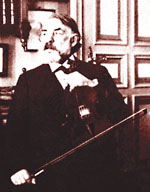 The famous Violinist
The famous Violinist
Joseph Joachim
Joseph Joachim about
Johannes Brahms
“To one
who knows him as well as I do, that is easily explained.
In spite of his crusty manner, Brahms is in reality a kindhearted man.
I have found that out in many ways. He realizes that for future generations
of composers, it would be of great value to have such detailed accounts
of his own experiences when in those trance-like states in which his inspi
rations came to him.
Those secrets
would have been invaluable to me as a young man. I also, through my early
associations with Mendelssohn and Schumann, before I met Brahms, had ambitions
to be a great composer; and if I had known then what I learned that last
evening with him, I might have accomplished a great deal more than I did.
Yes, I am convinced that he knows that young composers of the future will
profit by his revelations concerning those higher spiritual laws. He himself
gained very valuable information from the teachings of Jesus and of the
great poets.”
 Johannes Brahms
Johannes Brahms
“You see, the powers from
which all truly great composers like Mozart, Schubert, Bach and Beethoven
drew their inspirations is the same power that enabled Jesus to work His
miracles. We call it God, Omnipotence, Divinity, the Creator, etc. Schubert
called it, ‘die Allmacht’ but, ‘what’s in a name?’
as Shakespeare so aptly questions.
It is
the power that created our earth and the whole universe, including you and
me, and that great Godintoxicated Nazarene taught us that we can appro
priate it for our own upbuilding right here and now and also earn Eternal
Life.
According to Jesus’ own words, He was in that case not the great exception, but
the great example for us to emulate. We are all sons of God, for we could
not have come from any other source. The vast difference, however, between
Him and us ordinary mortals is that He had appropriated more of divinity
than the rest of us.
Of course,
to the disciples it appeared that Jesus was walking on the water, but in
reality He was walking in the air. His spiritual power was so great that
He could, by drawing on Omnipotence, rise superior to the Law of Gravitation.
We call that a supernatural power but supernormal would be a better term.
Jesus was using a higher law of which his disciples in the boat were all
ignorant, and their only explanation of the phenomenon was that He had supernatural
powers, being God Himself personified. Nevertheless, their terror was very
great for we read in Matthew 14:26, ‘And they cried out for fear’”.
Brahms
“How different life on this earth would be if we could all consciously appropriate
Omnipo-tence as Jesus did.”
Joseph Joachim
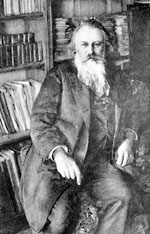 Johannes Brahms
Johannes Brahms
“My belief in our immortality is based chiefly on the unde-niable fact
that all peoples of all times and all climes have always clung to the belief
in a life beyond the grave; that is to say, the more spiritually advanced
leaders of such peoples.
There are, of course, always some who do not believe in a hereafter but
that is of no importance; the fact that so many different, widely sepa
rated races of antiquity did believe it, is to my way of thinking, proof
that it is implanted in the human breast by the Creator.
By burying
with their dead weapons, articles of clothing, and various utensils which
they had in daily use, they beleived that the dead would need them in the
next world. Ancient sepulchers and the many different modes of disposal
of the dead, reveal to us the hope which long since vanished civilizations
held of a future life.
One of the
most wonderful illustrations of the universality of the belief in another
life is to be found in your American Indians, who were wholly segregated
from all the rest of mankind, and yet they talked of the Great Spirit and
the Happy Hunting Grounds where they would hunt after leaving this world.
Their idea of heaven was a primitive one, to be sure, but one finds that
the conceptions of that abode were always coloured by the state of civilization
of the nations that believed in hereafter. However, all that is unimportant;
what counts is the universality of that belief in a future life.
In the Holy
Writ it says in John 14, 10: ‘The father that dwelleth in me, he doeth
the works’.
The real genius draws on the Infinite Source of Wisdom and Power as Milton
and Beethoven did.
That is, in my opinion, the best definition of genius. Jesus was the world’s
supreme spiritual genius, and He was conscious of appro-priating the only
true source of power as no one else ever was, although Beethoven and Milton
realized too they were tapping that same source in a lesser degree.
It is all a question of degree.”
Brahms
 Johannes Brahms
Johannes Brahms
“I always had a definite
pur-pose in view, before invoking the Muse and entering into such a mood.
Then when I felt those higher Cosmic vibrations, I knew that I was in touch
with the same Power that inspired those great poets and also Bach, Mozart
and Beethoven. Then the ideas which I was consciously seeking flowed in
upon me with such force and speed, that I could only grasp and hold a few
of them; I never was able to jot them all down; they came in instantaneous
flashes and quickly faded away again, unless I fixed them on paper.
The themes
that will endure in my compositions all come to me in this way. It has always
been such a wonderful ex-perience, that I never before could induce myself
to talk about it – even to you, Joseph.
I felt that
I was, for the moment, in tune with the Infinite, and there is no thrill
like it. I can understand why the great Nazarene attached so little importance
to his life. He must have been in much closer rapport with the infinite
force of the Universe, than any poet or composer ever was, and He no doubt
had glimpses of that next plane, He called ‘heaven’.
Shakespeare’s admonition ‘To thine own self be true’ has
always been one of my guiding principles.”
Brahms
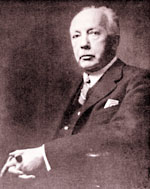 Richard Strauss
Richard Strauss
“..
but no matter how clever the workmanship, no composition will live unless
it is inspired.
Composing is a procedure that is not so readily explained.
When the inspiration comes, it is something of so subtle, tenuous, will-o-the-wisp-like
nature that it almost defies definition.
When in my most inspired moods, I have definite compelling visions, involving
a higher selfhood. I feel at such moments that I am tapping the source of
infinite and eternal energy from which you and I and all things proceed.
Religion calls it God.”
“It is of the utmost importance to put the thoughts on paper immediately lest
they quickly fade away. Once fixed I often look at them again and this conjures
up the same frame of mind that gave birth to them; thus the ideas grow and
expand. I am a firm believer in the germination of the idea.
I realize that the ability to have such ideas register in my consciousness
is a Divine gift.
It is a mandate from God, a charge entrusted to my keeping, and I feel that
my highest duty is to make the most of this gift – to grow and expand.
I was, however,
definitely conscious of being aided by a more than earthly Power, and that
it was responsive to my determined suggestions.
A firm believe in this Power must precede the ability to draw on it purposefully
and intelligently. That much I definitely know.”
Richard Strauss
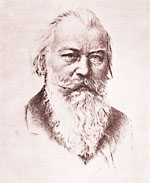 Johannes Brahms
Johannes Brahms
“I begin by appealing
directly to my Maker. Immediately after that I feel vibrations that thrill
my whole being.
These are the Spirit illuminating the soulpower within, and in this exalted
state, I see clearly what is obscure in my ordinary moods; then I feel capable
of drawing inspiration from above, as Beethoven did. Above all, I realize
at such moments the tremendous significance of Jesus’ supreme revelation,
‘I and my Father are one.’ Those vibrations assume the forms of
distinct mental images, after I have formulated my desire and resolve in
regard to what I want – namely, to be inspired so that I can compose
something that will uplift and benefit humanity – something of permanent
value.
Straightway the ideas flow in upon me, directly from God, and not only do I see distinct
themes in my mind’s eye, but they are clothed in the right forms, harmonies
and orchestration.
Measure by measure the finished product is revealed to me.”
Brahms
|
| |
CLASSIC-Life: Herr Hübner, you have created quite a number of pieces of work, which have
the title “The Art of the Feminine”. 16 of these have the subtitle
“Love”, and 16 further ones the title “Harmony”.
When you listen
to them, you notice that they are all related to each other. Can you tell
us something about this?
PETER HÜBNER: Yes, “Femininity” first of all is a delicate topic – during
a time in which, especially in high positions, more and more women effectively
stand up for themselves.
Like the whole of nature, the microcosm of music presents us creative powers, conserving powers, and destructive powers.
In the advanced civilisations of mankind the principles of “preservation”
were attributed to the feminine element, and “creating” and “destroying”
to the masculine.
I have transferred the principles of conservation from the microcosm of music
to the compositional, and used it in a fugue of up to five parts.
The fugue theme
can be frequently modified, without encroaching on the musical element of
femininity in any way.
In this respect,
the 16 pieces of work are modifications of the very same feminine themes.
Therefore, they differ from each other. It would require too much explaining
to go into this in more detail – you can hear it all anyway.
But there is also a special story behind this: all 16 pieces of work in a series
are related to each other. One would think that it would be easy to memorise
them, and musicians might assume that they would be able to play them from
memory after a short time.
But that is made especially difficult because of the close relationship of
these pieces – if not even rendered impossible
I therefore believe that a conductor, for instance, when he knows them all,
couldn’t conduct these pieces from memory – whilst he could easily
do so if he only knew one of them.
CLASSIC-Life: Among the “Art of the Feminine” there are the two cycles “Love”
and “Harmony”. In what way do they differ?
PETER HÜBNER: Regarding the 5 polyphone voices,
the particular individual movements are the same. But the series “Harmony”
also has the basso continuo, which reveals the natural harmonious development
– whereby this basso continuo is missing in the “Love” series.
Why these two groups
“Love” and “Harmony”? Here, I must explain in more detail.
Imagine five children who are playing with each other in a meadow. The ideal
natural harmonious contact of these five children is shown in the series “Love”,
the children being symbolised by five voices.
But the basis of a natural harmonious musical development can only be the basso
continuo – which is indeed not played here, but to which the voices are
directed. In the series “Harmony” this basso continuo is played,
and it embodies the mother.
Whilst in the series “Love” we experience the children’s play only
with the mother’s omnipresence, in the series “Harmony” we
experience the mother who is creating harmony in the basso continuo, and then
only recognise unambiguously in her the basis for the natural harmonious development
of the children’s play – the 5 voices.
The interesting
thing in “Love” is that in your subconscious – and the music
expert perhaps also consciously – with the help of the children’s
play: the 5 voices – you add the natural harmonious role of the mother
in the basso continuo, sometimes though making a mistake. But you only notice
this, when you later hear the corresponding piece of work with the corresponding
number from the series “Harmony” with the basso continuo, i.e.
with the role of the mother.
In natural harmonious
music, the basso continuo always determines the natural harmonious development,
and so the basso continuo determines here also the natural harmonious development
of the 5 voices – just as the mother determines the natural harmonious
development of her five children.
As this is about “The Art of the Feminine”, besides the mother,
the five voices represent five girls.
In “The Art of the Masculine” the father will correspondingly play
the decisive harmonising part as the basso continuo, and the children playing
are sons.
But the matter is even more specific: In the first 4 “Meditations” there
are not five different girls, but a girl playing by herself simultaneously
in 5 parts. Musically it is about a theme that is set up to fivefold in playing
musical motion within itselfintellectually guided and maintained by the
mother as a basso continuo in the series “Love”, and physically
and/or tonally in the series “Harmony”.
Thus, in “Love”
the mother is only present in the mind, and only determines the natural, harmonious
fivefold dance of the girl through her mental presence, and in “Harmony”
the mother is physically and/or tonally present, and in the basso continuo
we experience the natural basis of the harmony of the fivefold dance.
So far the “Meditations”
1-4 in “Love” and/or “Harmony”.
In the “Meditations” 5-8 we are concerned with the fivefold dance
of two girls. In the meditations 9-12 there is the fivefold dance of three
girls, and in 13-16 the fivefold dance of four girls.
The mother of all
four girls is one and the same – which you can gather from the development
of the basso continuo. And which of the girls is just dancing and in how many
parts at the same time, can be gathered from the themes you are hearing.
In an extended form, the “Metamorphoses” have developed from these
two cycles “Love” and “Harmony” – whereby the or
chestra was enlarged, as further motifs were added: new people of the musical
action and/or dance – girls and boys.
Now somebody might
ask: Why is he doing all this? Here, he is producing a number of musical pieces
with 5 voices in “Love”.
Then, he adds the basso continuo in a further series “Harmony”.
And finally in “Metamorphoses”, he brings in more musical themes
and motifs.
In “Metamorphoses”
I have included everything. So why would I want ”Harmony” and “Love”
as well?
Here we might have
the view of the music producer thinking of the economic aspect and/or the
music consumer, who thinks in terms of the laws of economicalness. The matter
has a different background.
Every person must learn to deal with himself harmoniously. Almost everybody
is aware of the fact that this is not easy and by no means always easy.
In “Love”
you, as the listener, can learn or get used to handling yourself simultaneously
in an up to fivefold way – harmoniously!
So you can learn to play 5 different parts simultaneously within yourself,
without facing dissonant and/or disharmonious collisions, but on the contrary
in a sensible togetherness – which is audibly proven by the music of
5 voices as a whole.
Where do you nowadays
find such a teaching and learning process? At home, in a nursery school, at
school, at university, in your job?
Such natural harmonious dealings with yourself is the pre-condition for natural
harmonious dealings with other people.
In the “Meditations” 5-8 – as I have already explained –
we are concerned with the fivefold natural harmonious dealings of two sisters
with themselves, and up to 5 x 5 = 25 fold with each other.
Thus, the learning
process is on the one hand the repetition of the fivefold dealings with yourself,
as learned in the “Meditations” 1-4. But in addition, we now have
the natural harmonious dealings with the sister, who at the same time handles
herself in a fivefold way. Correspondingly, the educational scale is extended
to No. 16.
In the series “Harmony”,
the knowledge is included that the same natural and inevitable laws of harmony
determine all our inner lives: two or several people deal with themselves
as well as each other according to the same harmonious laws.
The “Metamorphoses” extend this individual and social educational
process, and in addition, lift it into the ecological area. With the joining
orchestra voices, the individual, the social community and thereby related
and non-related people, and finally also the ecological conditions are integrated
into the harmonious play, according to the same laws of harmony.
Out of this “whole”
nobody would be able to hear with certainty the harmonious togetherness of
two or several people as well as the laws according to which this togetherness
develops in the “Metamorphoses”, if there wasn’t also “The
Art of the Feminine” the two groups “Love” and “Harmony”
in the cycle.
For the listener
is too much distracted by the additional voices of the orchestra in the “Metamorphoses”,
to clearly hear the fivefold conversation of an individual girl with herself,
or the part of the mother.
For this reason, it was and is necessary to record all three orders in a separate
form. That is classical music: Education for the soul, as Socrates calls it.
CLASSIC-Life: Herr Hübner, at your request, the picture of Maria was put on the CDs of
“Art of the Feminine”. Do you regard her as a special personification
of femininity?
PETER HÜBNER: When I first saw this portrait of the Pieta in St Peter’s Cathedral in
Rome – that was in 1972, I spent about half a year near Rome, and travelled
quite regularly into town – I was deeply impressed by this work of Michelangelo.
You have to imagine: a mother has just seen her son murdered – the worst
that could ever happen to her.
We are used to women
turning hysterical, when they lose their handbags or their husbands stray.
The average citizen all over the world would expect a women who has just lost
her son, to be absolutely care-worn, and this to be expressed on her face.
No sign of all that in Mary, as portrayed by Michelangelo.
And if you then
look at her son in her arms, then you probably first notice the crown of thorns
and the serious wounds, but finally you see the face of a very alert, absolutely
relaxed man resting in his mother’s arms.
For me, the Jesus in this portray was more alert and more present than most
of the people who were wandering around St Peter’s Cathedral. He seemed
to be simply resting thoroughly and relaxing.
What I also noticed
was that he was much bigger than his mother, and that he seemed heavy –
but nevertheless she was holding him without any effort in her arms, as if
he had no weight at all.
This portrait of
mother and son made me think hard. Obviously Michelangelo had managed to present
him as an immortal soul: wide awake, resting deeply, completely relaxed, full
of life, and despite the outer wounds and the crown of thorns on his head
also completely without pain.
And obviously his mother saw him like that, too, and was neither blinded by
wounds nor death nor weight.
That is why she
wasn’t suffering. This Mary was obviously living beyond birth and death,
and recognised her son as being immortal. And she wasn’t older than her
son, either.
Most men think, when they father a child, that they are the creator of this
child and that is why the child is to bear their name. In my opinion, women
are a little more restrained in this respect.
When somebody is
the creator of something, he usually knows what he is the creator of –
at least that is what one would think.
But the men who are fathering a child do not know of what they are the creator,
although they think they are the father, and also say that they are. They
don’t even know if it will be a boy or a girl – never mind the rest.
But then who is
the creator of this child? Somebody must be the creator and know what he is
creating. I have the impression that Michelangelo knew and expressed a lot
more of this than most people would guess.
A mother giving birth to an immortal child, a son who was murdered, but lives,
who – although physically existing – is absolutely without weight
for his mother: that shows me a vision of life’s reality which in many
ways does justice to superior ideals. For this reason, I asked – when
we are dealing with ideal femininity – to use this picture of Mary.
This reality –
as Michelangelo expressed in his Pieta – I also tried to express in the
“Hymns of the Domes”, whereby the slightly louder intermediate parts
also remind of such ignorant views of people who in their narrow-minded limited
understanding of creation imagine that it was possible to kill Christ and
thereby harm his mother.
The name “Mary”
is also interesting, because originally it meant “cosmic ability to think
and universal creativity”, and the person who extends his thinking, can
hear this name more and more clearly in his inner being.
I hope the “Art
of the Feminine” and the “Hymns of the Domes” do justice to
the claim and the view of Michelangelo.
The central themes in “Hymns of the Domes” come from the “Art
of the Feminine”. Thus, I have arranged the “Art of the Feminine”
for the organ, and I have called these arrangements “Voice of the Domes”.
It is interesting
that we have the same view of the world and/or of life as we find with Michelangelo,
and probably also at least among the people in higher positions in the catholic
church – because otherwise the portrait wouldn’t be in St Peter’s
-, in the Bhagavad Gita.
Here, we have Krishna,
resting in himself, fully conscious, not active, and Arjuna, his student,
who knows his immortality. Krishna symbolises the immortal soul like Christ,
and Arjuna characterises the cosmically developed powers of cognition, which
in the end cannot be deceived by the confusion of the raging world events.
In this respect,
I see a perfect, outstanding presentation of that phenomena of yoga in Michelangelo’s
Pieta: better, more convincing, more comprehensible than I have ever seen
in a picture in Asia.
If someone asked
me to portray yoga and its principles in the best possible way, I would choose
the picture of the Pieta to do so – whereby the real understanding clearly
only develops, when you know the whole story: about the mother and the murdered
son, and the various levels of knowledge of this matter which I have already
explained – starting with the murdered son and the suffering mother to
the immortal son, and the mother who is therefore not suffering.
The path of yoga is exactly the path of ignorance to the knowledge of these
facts. I have learned yoga, I spent a long time in Asia in the Himalayas for
this purpose, and I practised yoga – in the late sixties, early fiveties
I taught thousands of people yoga, and I know what I am talking about.
In different cultures and religions there are many portrays of goddesses of
wisdom.
When I see those
pictures, I don’t know what would bring me to the conclusion this is
an expression of “wisdom”. It is not possible for me to follow the
thought, that this is a portrayal of a wise woman.
But when I see Mary, as portrayed by Michelangelo, and I know the background
story, then her unstressed, youthful appearance can only be explained in such
a way that she must be wise, because otherwise she would look bowed down with
grief, as this is indeed the case with a lot of pictures of Mary, which have
been created by ignorant artists – where her creators seriously imagine
those Romans would have been able to murder God’s son and bring disaster
on his mother.
It is surely the
most terrible thing that can happen in the world, that somebody murders a
mother’s son – there is nothing worse. But if she subsequently does
not suffer, she is either completely callous or without conscience, or she
is wise and knows about immortality. This picture of Mary has an extremely
meditative effect – it is worthwhile having a look at her, closing your
eyes and doing a bit of soul-searching, internalising it and learning to regard
the world with the eyes of this woman.
That is why I also
recommended that picture of Mary to the publisher’s for the label „Peace
of Mind“ regarding spiritual music.
|
|

